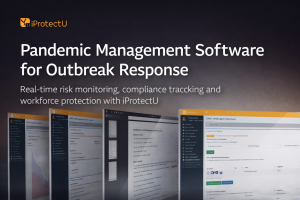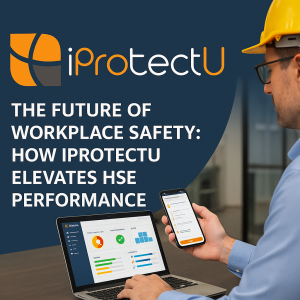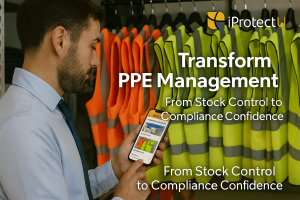iProtectU Feature in the Irish Health and Safety Review
iProtectU Managing Director Wayne Beck and International Compliance Director Sally Beck, join some of Irelands leading companies and organisations in an article by IRN News – Health and Safety Review.
Read the full story below.
In 2023, Ireland was placed in the top 10 international performers in the 2023 Digital Government Index (DGI). Ireland’s national digital strategy, Harnessing Digital – the Digital Ireland Framework, also confirms its commitment to transforming the public service using digital initiatives such as the digital covid certificate, online driving licence renewals, and online passport applications.
The public sector is not alone in its drive towards transformation, and more and more workplaces are looking towards technology to help solve a problem, expediate their services or processes, and in the long term reduce their costs. To help manage the risks from this technology revolution, the European Union (EU) Artificial Intelligence (AI) Act was recently endorsed by all member states, with key obligations coming into effect in the next 24 months. One of the main risks for workers is the use of emotion recognition technology, which will not be allowed in the workplace, under this Act.
To gather an insight into how occupational safety and health (OSH) professionals view the changes in digital technology in the workplace, HSR spoke with both providers and users of the technology, to gain a better understanding of both the challenges and opportunities.
Safety in automation
According to John McAuliffe, managing director with Pilz Ireland Industrial Automation, whether a company has already adopted automation into its processes, or it is considering doing so, it is important for the OSH professional to understand what the current hazards are, and what new hazards will be introduced. He also made the point that new technology can also move safety to a higher level, by reducing administration in both operational and safety tasks.
Speaking with HSR, he gave the example of a “digital twin”, of plant and machinery, which can be used to train workers in a potentially safer environment, before the real version comes into use. It can also create the plant and machinery risk assessments and procedures. “This will shift the role of the OSH professional from completing the paperwork, to reviewing the paperwork”, he advised.
John McAuliffe, managing director with Pilz Ireland Industrial Automation,
Discussing what the OSH professional needs to aware of in relation to machineryautomation, John recommended familiarity with the essential health and safety requirements listed in Annex 111 of the EU Machinery Regulation (2023/1230), as well as the minimum health and safety requirements in the Use of Work Equipment Directive 2009/104/EC. “These will guide you as to what your organisation needs to be aware of using machinery in automation, he said.
(More information on the EUMachinery Regulation is at https://www. healthandsafetyreview.ie/article/8398).
Understanding Customer Needs
Sally Beck, International Compliance Director with iProtectU, who provide customisable Environmental, Health and Safety (EHS) software compliance solutions, told HSR that from their perspective.
"If you don’t understand your customer’s needs, you won’t be able to deliver. It is critical to understand the customer’s business operating environment and what they are trying to achieve".
Sally Beck, International Compliance Director - iProtectU
Sally explains it is important to spend time in the early stages understanding the organisational structure of the company, their reporting requirements (who, when and how often), their preferred report format, and adjusting the terminology in the software to match the terminology used by the company.
"Products that can be customised to meet client requirements and expectations succeed in terms of delivering performance and user engagement. Generic software products can have significant limitations in terms of relevance and applicability to the specifics of a company".
Wayne Beck, Managing Director - iProtectU
Sally is also cognisant of employees who may not feel “IT savvy”, and may be fearful of engaging with new software, and believes it is important to support these individuals through the customisation and implementation stages.
"“It can be helpful to buddy someone up with another colleague who is more comfortable with IT systems”, she says, as well as ensuring they understand what the benefits of the technology will be for their role".
Sally Beck, International Compliance Director - iProtectU
Compliance, control and consistency
Another advocate for the benefits of workplace digitalisation is Mercury Engineering’s environmental, health and safety (EHS) director Michael O’Connor.
"Constantly pushing forward with digitalisation” and believes it is of great value to maintain EHS compliance, control and consistency. “Companies must embrace technology to expand, and if it is set up correctly, it can enhance human to human interaction, as well as ensuring that documents and forms are stored centrally, are traceable and updated easily".
Michael O’Connor - Mercury Engineering Environmental, Health and Safety (EHS) Director
Commenting on some of the helpful uses of technology in Mercury, he is obviously pleased at the successful implementation of their “digital kiosks”, which are stand- alone units with an interactive screen, allowing users to report good and bad safety practices in seconds (refer to HSR July/Aug 2023, link: https://www.healthandsafetyreview.ie/ article/8227).
He also acknowledges there are benefits with ‘digital permit’ systems, which can be date-stamped, and have photos of the work area uploaded, online Risk Assessment Method Statements (RAMS) which can be shared and comments added to between contractors and subcontractors before being approved, and digital notice boards on sites which can be centrally updated and maintained current easily.
Preventing risks
With these obvious benefits, there are also potential risks, and according to the European Agency for Safety and Health at Work (EU-OSHA), in its healthy workplaces campaign, which is themed ‘Safe and healthy work in the digital age’, consultation and participation of workers is key to preventing and managing these risks.
"Digitalisation in technology is not good or bad, the key determinant is how it is developed and put into practice” and ensuring that risks are identified and managed".
William Cockburn, EU-OSHA Executive Director
Gas Networks Ireland‘s networks safety manager, Owen Wilson, has also seen a transformation in the energy utility sector during his 20 years with the organisation. Talking with HSR, he noted that Gas Networks Ireland first introduced domestically produced biomethane – a carbon neutral renewable gas – onto Ireland’s gas network more than two years ago and it is seamlessly replacing natural gas, as well as being fully compatible with existing appliances and technology.
With one renewable gas, biomethane, successfully being piped through the Irish gas grid, Gas Networks Ireland is preparing for the introduction of the next renewable gas – hydrogen.
"As well as introducing these renewable gases, we have changed how we worksaid, with a lesser emphasis on paper-based systems (although these are still needed for certain activities such as leaving a paper copy of a hazard with a customer), as most of their crews, fitters and technicians are now using tablets, laptops or hand held devices to manage information during installation and maintenance activities."
Owen Wilson - Gas Networks - Ireland‘s networks Safety Manager
Human interaction
Discussing with Owen the safety risks involved in the introduction of new technology, he believes that it is important to understand how new technology will interact with humans. “If it’s the right technology, used in the right place, at the right time, and people perceive it to be valuable to their role, there is a higher chance of success”, he explained. If people believe the technology will make their job harder or more time-consuming to do, there is a risk they will not engage with it and will find ways around having to use it.
On the topic of cloud technology, which can be used to automatically generate risk assessments from a video recording of the work environment, he noted that like all technology it may suit certain work scenarios, but perhaps not all. Potential users should assess any new technology in line with the needs of their own organisation, their risks, their workforce and company culture, and then decide if it is right for them, he said.
As risk identification and management is a core part of the work completed by OSH and environmental professionals, their input during the design and implementation stages of technology is very valuable. Owen elaborates further on this, saying that the role of the OSH professional is to “advise, support, measure and assure”, and the assurance aspect is important to reassure workers that everything is being done correctly.
Upskilling employees
The OSH professional should be part of the team, or as a minimum part of the process during the introduction of technology, Owen says. They do not need to become technologists, as there are experts who can provide this knowledge, but they do need to understand what is needed, what is planned, what the human interaction will involve, and how to communicate, influence and gain the buy-in of users to support its implementation.
It is also helpful to ask questions at the design stage about what can go wrong with the technology and what happens if it does, says Owen. For example, if data is incorrectly input, what are the consequences, to the user, the process and the organisation?
From an organisational perspective, there is a responsibility to ensure that employees and users of the technology are comfortable using it and are not afraid to engage with it, and this requires upskilling, according to award winning researchers and professors Paul Leonadi and Tsedal Neeley.
Their book, The Digital Mindset: What it really takes to thrive in the age of data, algorithms and AI, suggests that companies who support their workers to become aware of the possibilities that technology can enable, will not only transform their work practices but also their workforce. Recognising that some people can feel intimidated by technology, they recommend that giving employees a level of “digital literacy” that empowers them to buy into it will encourage success.
Safety inspection technology
Reflecting on the significance of ensuring employees are provided with the appropriate level of information and training, deputy chief executive with the Health and Safety Executive Northern Ireland (HSENI), Bryan Monson talked to HSR about new technology in their workplace inspection process.
“We now have drones to access locations that can often be dangerous for inspectors to go into, such as unstable faces in a quarry or areas which have suspected asbestos material”.
Bryan Monson - Health and Safety Executive Northern Ireland (HSENI)
He explained that they have trained the users of these drones to a level where they are licensed with the Civil Aviation Authority in the UK, as well as implementing their own policies and procedures on the use of the drones. “It has greatly reduced the risk to our staff and allows photographs and evidence to be recorded virtually, which is fed back to the user, who can then safely review it and decide what decisions need to be made next”, he said.
Cost and capabilities
Discussing other areas where new technology is improving worker safety, he noted advancements in the waste handling and transport sector, where some vehicles are fitted with AI thermal imaging, which alarms if the vehicle is too close to a pedestrian or object. “The data from this technology can also be used to identify where ‘hot spots’ are and to rethink traffic routes”, he added.
Whilst providing many benefits in terms of safety and efficiency, there is also a cost associated with the introduction of new technology, which may impact on the speed of its uptake. According to a report in the Financial Times, Julie Sweet, chief executive of Accenture, an information technology company, made the point that cost is likely to slow down the uptake of some technology, in particular AI. Another concern is many companies hoping to use AI lack the technical know-how.
“Most companies do not have mature data capabilities, and if you can’t use your data, you can’t use AI”.
Julie Sweet, Chief Executive of Accenture
With so many factors at play, it will be interesting to see how the digital revolution evolves in the workplace, and how worker safety and the management of the safety process will be impacted. Remote working evolved as the new way of working after the pandemic, and 2024 could be the start of another new way of working for many.
References and contacts featured in this article include
Ireland’s national digital strategy, Harnessing Digital
– the Digital Ireland Framework: http://tinyurl. com/39kajc23
The Digital Mindset: What it really takes to thrive in the age of data, algorithms and AI by Paul Leonadi and Tsedal Neeley.
EU-OSHA Healthy Workplaces Campaign – Safe and Healthy Work in the Digital Age: http://tinyurl.com/ yymdefna
Pilz, automation technology. Website: https://www.pilz. com/en-IE.
iProtectU, EHS software compliance solutions. Website: https://iprotectu.com/about-iprotectu/ . Email Sally Beck on sally@iprotectu.co.uk
For the full story by Margaret Kirby at IRN News please visit Irelands Health and Safety Review.








